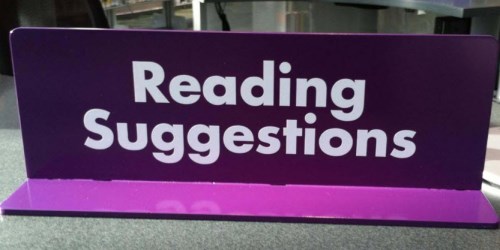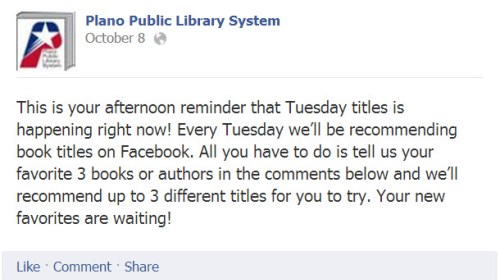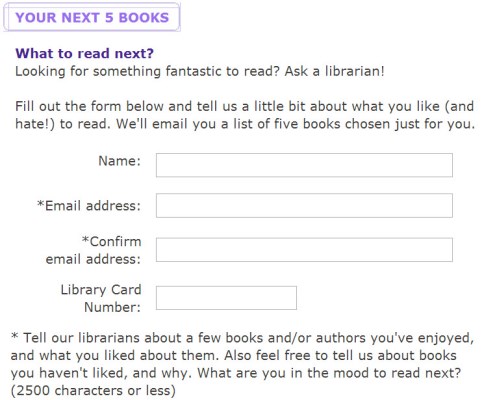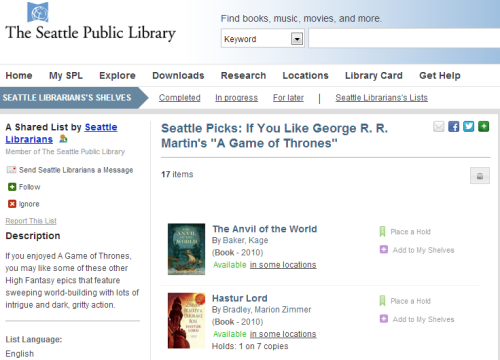Readers Advisory: Fresh Approach, Same Core Service
 Experts from Seattle Public Library's (SPL) Reader Services Department recently shared their enthusiastic and innovative approach to Readers Advisory in the WebJunction webinar Serving Readers: Beyond the Basics. As libraries evolve and adapt to changing circumstances, it is crucial to their continued community relevance that they retain and serve their core constituency of readers.
Experts from Seattle Public Library's (SPL) Reader Services Department recently shared their enthusiastic and innovative approach to Readers Advisory in the WebJunction webinar Serving Readers: Beyond the Basics. As libraries evolve and adapt to changing circumstances, it is crucial to their continued community relevance that they retain and serve their core constituency of readers.
Readers Advisory librarians David Wright and Andrea Gough expanded on the basic premises and practices of Readers Advisory, sharing how to apply these practices across new platforms and technologies, enlist social media and catalogs to serve readers, and use form-based and virtual Readers Advisory for libraries of all sizes.
Engaging Readers in New Contexts
Traditionally, Readers Advisory has occurred as face-to-face interaction between library staff and patrons, or through indirect prompts, such as displays, shelf talkers, or posted book lists. The common thread in traditional Readers Advisory has been the ability to engage with readers directly, at the library. As more and more people access library services remotely, library staff can employ an array of tools to maintain that meaningful connection with their patrons and provide personalized readers services, both inside and outside of the library.
Forms
Reader input forms provide an opportunity for patrons to indicate their literary passions, which library staff can then use to respond with customized catalog examples. These forms can be produced and distributed in hard copy, or posted online. SPL’s online form, Your Next 5 Books, allows patrons to share their literary passions and receive customized catalog recommendations from a library staff member within days. SPL has received and responded to over 3,000 of these forms in the past 2 years, which, in addition to providing personalized service to readers, also promotes a continuous feedback loop between the library and the community. SPL highlights some examples of reader inquiries and library recommendations at their Shelf Talk blog. Additional examples of online forms used by other libraries are available on the archive page, and range from fairly concise to very robust!
Social Media
As with any communication channel, a library’s use of social media is largely driven by community context and internal capacity. SPL provided several suggestions for engaging with booklovers using social media, applicable to communities where libraries are already connecting with their patrons online, as well as those libraries working to build that online presence.
 Libraries can use Facebook to post prompts or questions that spark a dialogue about what people are reading, favorite authors and genres, etc. Plano Public Library hosts Tuesday Titles each week, a live Facebook discussion between staff and patrons about reading recommendations. Libraries may also use Twitter to spark these discussions, as well as blogs to feature patron or staff generated reading lists or book reviews. Traditional media outlets may increasingly look to community content generated by libraries to inform their material, such as The Seattle Times books section, which features information on the top 5 ebooks at the Seattle Public Library.
Libraries can use Facebook to post prompts or questions that spark a dialogue about what people are reading, favorite authors and genres, etc. Plano Public Library hosts Tuesday Titles each week, a live Facebook discussion between staff and patrons about reading recommendations. Libraries may also use Twitter to spark these discussions, as well as blogs to feature patron or staff generated reading lists or book reviews. Traditional media outlets may increasingly look to community content generated by libraries to inform their material, such as The Seattle Times books section, which features information on the top 5 ebooks at the Seattle Public Library.
Like the use of forms, successful Readers Advisory via social media is largely dependent upon libraries creating an opportunity for patrons to provide their own input and perspective, and drive the conversation based on what matters to them. Social media may allow the conversation to move beyond books as well, and can be used to crowd source community input on collections or programs. Generating these public conversations may present new opportunities for partnership for libraries, in addition to new avenues for patron engagement.
Creative Cataloging
Many catalogue interfaces now support new means for Readers Advisory, including posting recommended reading lists customized to a patron, as well as suggesting alternate titles for materials that may be on hold. SPL provided an example of their While You’re Waiting For… feature, which links to books in the collection that are similar to those that are flying off the shelf. Increasingly connected cataloging allows patrons to connect with the diverse offerings in a collection, and understand that the library has something relevant for them, no matter what.
While the tools for successful Readers Advisory continue to diversify and evolve, the foundation of personal connection remains the same. By using new means to identify and respond to patrons’ personal reading preferences, libraries create new opportunities for community engagement, and keep the wonderful world of the book at the forefront of library services. Watch the full archive and learn from these inspirational RA leaders!


